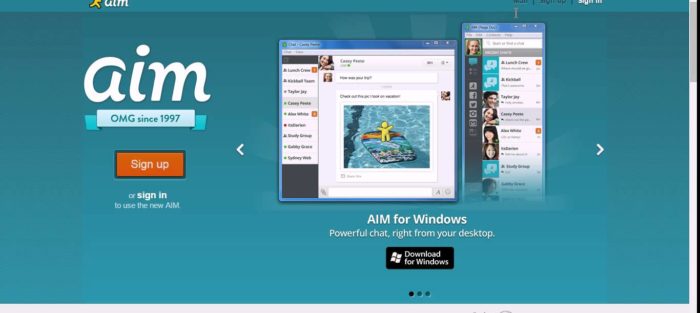AOL today announced that it has launched Open AIM 2.0, an update to the API and SDK the company provides to third-party instant messaging developers who write clients and services for use with AOL’s AIM network. AOL announced the first version of Open AIM one day shy of two years ago.
In its first release, Open AIM was largely characterized by the technical advantages it conferred on third-party developers by providing a flexible SDK that worked with a number of popular programming languages in the Windows environment. At the same time, its license was somewhat protective of AIM, prohibiting developers from using it with multi-network IM clients such as Trillian or Pidgin.
Though some developers are still uncertain of how (or if) they can take advantage of the new release, AOL has lifted some of the restrictions it placed two years ago, and it has provided more access and documentation to OSCAR, AIM’s key protocol. With Open AIM 2.0, a number of OSCAR features are now exposed through the new APIs. Spokespersons for AOL confirmed that SSL encryption, for instance, is now available to third-party developers.
Unsure about an IM abbreviation?
Check out our listing of more than 600 definitions.
Other changes to Open AIM include more tools for mobile application developers, the elimination of per-day and per-month usage limits, opening AIM’s APIs to international use, and the introduction of AIM Money, an advertising revenue-sharing program the company has not yet described in detail.
In return for expanded access to APIs and the AIM network, AOL requires developers to use any two of five features in the clients and applications they develop using the new release:
- a display ad, with revenue sharing provided using AIM Money
- bundling the AIM Toolbar, which provides access to a number of AOL’s services and optional add-ons from third-party sites
- access to AIM Expressions, a collection of wallpapers, buddy icons and other elements, some with commercial tie-ins, that allow users to personalize their messaging software
- display buddy info
- display the AIM Dashboard as the start page at launch
In today’s announcement, the company said that it has already signed two IM developers on to use the new release: meebo and eBuddy.
Previously on AIM
- Google Adds AIM to Chat for Gmail
- AOL Calls On IM-based VoIP
- AOL Takes AIM at the Masses
- AOL Adds Platforms, Functionality to Open AIM
- New SDK Opens AIM to Developers
Stuck for a definition? Look it up at Webopedia:
In an interview with Instant Messaging Planet, Martin Green, vice president of business development at meebo, said his company isn’t ready to announce any new features at this time, but he said developers are beginning to dig into the updated API and plan to add features “in an evolutionary fashion.” Green also noted that increased personalization and improved contact information are likely changes resulting from the updated API.
“Codifying this relationship certainly helps everybody. There are a lot of features and products we want to build. It’s helpful to have a base and a common understanding.”
Green also said Open AIM’s increased openness to outside developers promises to advance IM development over time. “The larger issue,” he said, “is [that] IM has been huge for ten years, but it’s always been closed. … Codifying the rules of engagement around openness is hugely helpful for hundreds of millions of users.”
Open AIM and Open Source
Evan Schoenberg, lead developer of the Adium project, an OS X IM client that uses the Free Software library libpurple, said signs that Open AIM was increasing its openness came weeks in advance of today’s announcement. In an interview with Instant Messaging Planet, Schoenberg said he spoke with John Bracken, director of business development with AIM Business Services, along with another employee involved in AIM’s development; about the ways in which Free Software and Open Source developers can take advantage of OpenAIM 2.0.
Schoenberg said his ongoing interactions with AIM personnel are a new and encouraging development in the relationship between AIM and Free Software developers who write clients that work over the AIM network. At the same time, he said that even with the updated Open AIM, concerns remain that may prohibit Free Software developers from using everything the new API and its attendant libraries provide.
“It’s legally impossible for Adium to join OpenAIM so far as I can tell,” said Schoenberg. “I’m not a lawyer,” he continued, “but I do know the GPL — the GNU Public License under which Adium is distributed.” The GPL provides a way for programmers to share the source code to their applications with other programmers while requiring the recipients to share any changes they make with others, and it prohibits the recipients from placing further restrictions on redistribution of their changes.
According to Schoenberg, “the OpenAIM Developer license is riddled with the phrase ‘AOL grants you a free-of-charge, limited, non-exclusive, non-transferable, non-sublicensable license during the Term…,’ however, the GPL is inherently transferable; it would be a clear violation of the license to link into the program code which I could not distribute in source form with the same terms I used myself.” In turn, he said, that rules out the use of the libraries AOL provides with the Open AIM SDK.
At the same time, even though some elements of Open AIM may be off-limits to developers working with software under a Free Software or Open Source license, those developers do have open access to more documentation than AOL has previously made public.
“AOL has done more than just released their prebuilt libraries with new, less restrictive terms,” he said. “They’ve also published some documentation on the OSCAR protocol, the first time this has been done by AOL, and that’s a great move on their part; I’m happy to see them doing so.”
Schoenberg said that, unlike the libraries included with the OpenAIM SDK, the information in the newly opened documentation is freely accessible and does not require acceptance of the Open AIM license to use.
According to Schoenberg, the documentation “doesn’t change the state-of-the-art for the open source community,” but he plans to investigate whether voice and video elements of AIM’s protocols are now documented, which would advance the efforts of projects like his to include those technologies in their clients.










Comments are closed.